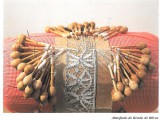Este post também está disponível em:
Português
English

Bobbin lace is a source of budget supplementation, distraction and link between the women who mark the history of the Northeast and the Morros da Mariana.
The lace is present in clothes, scarves, towels and other articles, have an important economic role in the North, Northeast and South regions.
The so-called cushion or bobbin lace is developed by the hands of lace makers who work with a cushion, a cardboard full of holes, thread and bobbins (small wooden pieces similar to spindles).
Brought by the Portuguese and the Azorean settlers, this technique is a traditional work from various points of the Brazilian coast.
The lace is made on top of a cushion stuffed with carnauba straw, where a design is placed that serves as a mold for the braiding of the bobbins.
Videos about bobbin lace

To make the embroidery, the lace makers use pieces of wood glued to a typical coconut of the region known as ‘tucum’.
The cardboard is passed down from generation to generation and some motifs are unique to one family. Although lace is not originally a Brazilian product, it has become a local product through acculturation.
Lace, whose historical origin dates back to the 15th and 16th centuries, and whose paternity is claimed by Flanders and Italy.
Flanders calls itself the inventor of bobbin lace and Italy claims the patent for needle lace, from which Renaissance lace originated.

As the first category of lace, we find the lace made with bobbin, called “bobbin lace”.
The bobbin is a small instrument composed of a short rod whose tip has a spherical shape. At the other end of the rod is attached a quantity of thread, which in the handling of the artisan, is attached to a standard design or drawing of the lace to be developed.
The production of this type of lace requires the use of several bobbins, whose quantity varies according to the complexity of the design. Bilro lace is produced on cushions resting on the artisan’s lap, or sitting on a wooden easel in front of her.
The yarn used by bobbin lace makers is cotton, predominantly white because of tradition and because it does not hinder vision. The mold used is called “pique”.
The design models are old, being passed down from one generation to another. In order to obtain new models, the lace-makers borrow the piques from each other, or get samples from other places.
Some rare lace-makers make the lace from the head, without using a mold.
Bilro lace created can take several forms
- beaks or tips that will be used to decorate edges of fabrics, or to be applied between two pieces of fabric.
- bedspreads, tablecloths, centerpieces and napkins.
- lace in the form of flowers, hearts, fans, among others, for applications on fabric, to decorate it.
- flaps: whole pieces, which will be used on necklines of sweaters, blouses and dresses.
Lace and Embroidery in Ceará
Lace and embroidery activities are the predominant handicraft in Ceará, present in about 104 municipalities.
According to the Monitoring System of the Ceará Handicrafts Center SAC-CEART, 700 artisans are registered for the “bobbin lace” typology, where 99.4% are women and 0.6% are men.
Records indicate that this typology has existed in Ceará since colonization, having spread inland and in coastal areas, concentrating mainly in the municipalities of Aquiraz, Aracati, Beberibe, Acaraú and Trairi.
The development of handicrafts can become a hallmark of the region. This is the case for the district of Prainha with the Renda de Bilro, located in the municipality of Aquiraz.
The municipality of Aquiraz has more than three centuries of existence, and an estimated population of 80,000 residents.
The strong tourist appeal and a history related to handicrafts stand out as its relevant characteristics.
Bilro Lace in the Northeast




















